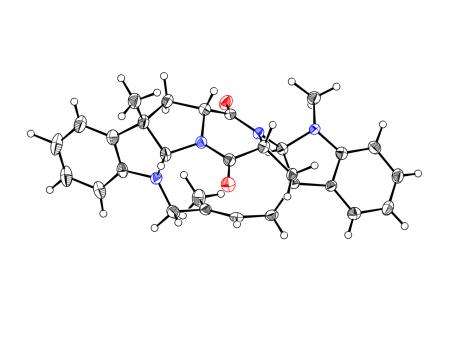How organic chemists tweak existing molecules and build new ones from scratch

Natural products—molecules originally isolated from bacteria, fungi, plants, and other sources—often have medicinal values that can be enhanced by careful reengineering. For example, an aspirin tablet is a much better pain reducer than an extract of willow bark. Chemistry professor Sarah Reisman's lab develops synthetic methods to help organic chemists tweak existing molecules and even build new ones from scratch.
Q: What do you do?
A: I'm a synthetic organic chemist. I spend a lot of time thinking about how to make small, carbon-based molecules—roughly the size of steroids, and comparable to most pharmaceuticals—that have some sort of biological activity. We try to prepare them in our laboratory so that through collaborations we can figure out how they work. We're more on the basic-research side of the spectrum; we develop synthetic tools that we, or researchers in pharma, can use to build molecules.
Natural products are relatively rare compounds. For example, the important antitumor drug Taxol—which we do not work on—was originally isolated from the Pacific yew tree. The yew population would have been decimated if the tree had been used as the commercial source of paclitaxel, which is the generic name for the drug. The manufacturers figured out how to culture an intermediate compound and finish the preparation synthetically, but first the demand for material inspired several chemical syntheses of the natural product.
Total chemical syntheses of natural products are complicated endeavors, because these molecules have very specific three-dimensional structures. The reactive parts that give the molecule its function all have to be connected in the correct spatial orientation, so how you bring the atoms together is really important. You have to figure out how to selectively engage and modify one part of the molecule without messing up the rest of it. Organic chemists have spent a long time developing these types of selective reactions, which is really what we do in my lab. And despite constant advancement in our understanding of synthetic organic chemistry, it is very much an empirical science. There are all sorts of rules and guidelines, but there are frequently exceptions to the rules and that's where things get interesting.
Working out the best order to do things is a big part of the challenge. We want to make these molecules in a reasonable way—usually in 20 synthetic steps or less. That's still on the high side, but it's reasonable. It's rare to obtain a 100 percent yield, and 20 synthetic steps with even a 75 percent yield at each step would lead to a very low overall yield. So we look for high-yield transformations wherever possible.
Q: What's exciting about this? What motivates you?
A: Well, I think it's pretty neat that most of what we make has never been made before. The goal is to make some compound that nature produces, but we get to design new molecules along the way.
We usually start with the target molecule and work backward—using either known transformations, or our intuition about reactions we might be able to develop—and as we simplify the target, we get to compounds that haven't been made before. Then we ask ourselves, okay, how do we actually make those compounds? And we work our way forward to those checkpoints—again, using known reactions, or new ones that we develop—but now starting from commercially available chemical building blocks.
I was drawn to organic chemistry because there's a tremendous amount of creativity embedded within it. There is no definitive right way to make a molecule. It's like putting together a jigsaw puzzle where you get to cut your own pieces. You figure out how to break the molecule up, and then how best to reassemble it. It's a lot of fun.
Q: How did you get into this line of work?
A: When I went to college I wanted to go to medical school. My declared major was biology, because I had heard that that was a good way to get in. Then, as a sophomore, I had to take organic chemistry as part of the premed requirement. I got hooked. It was unlike any other chemistry course I'd ever taken, because it was so creative. After I got into an organic chemistry lab and did some research, there was no looking back.
Provided by California Institute of Technology


















